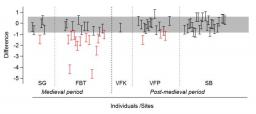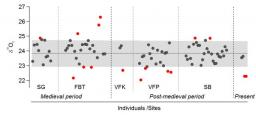
Immigration and mobility in the mediaeval and post-mediaeval periods in Norway has, up until now, mainly been discussed on the basis of historical sources. This paper presents the results of stable oxygen isotope d18O analyses of the 1st and 3rd molars from 95 individuals from mediaeval and post-mediaeval Trondheim, as well as new information about the d18O composition in the precipitation and drinking water in Trondheim. Through these analyses, the authors have attempted to shed light on the age of migrating individuals and directions of the migrations, investigate temporal changes with regard to migration, as well as making suggestions regarding the proportion of immigrants to locals in the population. The results show that the majority of the immigrants have come from areas to the north or east of Trondheim, and some have travelled, at least, 800-1000 kilometres to have come to Trondheim. It has also been shown that a large proportion of the mediaeval individuals moved during childhood (Fig. 1 & 2). Both with regard to child mobility and migration in general, the evidence suggests that the migratory activity decreased from the mediaeval to the post-mediaeval period.
Immigration and mobility in the mediaeval and post-mediaeval periods in Norway has, up until now, mainly been discussed on the basis of historical sources. This paper presents the results of stable oxygen isotope (d18O) analyses of the 1st and 3rd molars from 95 individuals from mediaeval and post-mediaeval Trondheim, as well as new information about the d18O composition in the precipitation and drinking water in Trondheim. Through these analyses, the authors have attempted to shed light on the age of migrating individuals and directions of the migrations, investigate temporal changes with regard to migration, as well as making suggestions regarding the proportion of immigrants to locals in the population.
The results show that the majority of the immigrants have come from areas to the north or east of Trondheim, and some have travelled, at least, 800-1000 kilometres to have come to Trondheim. It has also been shown that a large proportion of the mediaeval individuals moved during childhood (Fig. 1 & 2). Both with regard to child mobility and migration in general, the evidence suggests that the migratory activity decreased from the mediaeval to the post-mediaeval period.
Suppersberger S. and Daux V.
Reference : Journal of Archaeological Science: reports, Vol. 8, pages 416-425, 2016.
Open access : http://authors.elsevier.com/sd/article/S2352409X16303297







